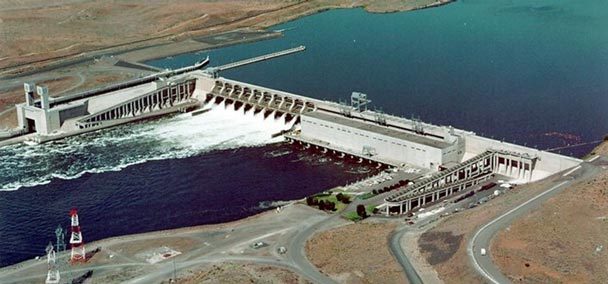forum
library
tutorial
contact

Lower Snake River Dams Have
a Long History of Controversy
by Becky Kramer
Spokesman-Review, October 24, 2016
|
the film forum library tutorial contact |

|
Lower Snake River Dams Have
by Becky Kramer
|
Critics of the Lower Snake dams included the Washington state Department of Fisheries, whose director argued for
preserving the free-flowing Lower Snake and access to its productive tributaries, the Clearwater and Salmon rivers.
 The Lower Snake River dams have always been controversial, Idaho historian Keith Petersen wrote in his 1995 book about the dams, "River of Life, Channel of Death."
The Lower Snake River dams have always been controversial, Idaho historian Keith Petersen wrote in his 1995 book about the dams, "River of Life, Channel of Death."
Early on, fish advocates worried about how the dams would affect salmon survival, he wrote.
Salmon and steelhead have shrunk from the prodigious runs described by early white settlers, but they had stabilized by the 1930s and were important to the economy of small Northwest towns.
Also in the 1930s, several groups had formed to promote barge traffic from Lewiston to Portland. Inland Northwest farmers were paying railroads nearly $5 per ton to ship their wheat to Portland or Seattle. They wanted more competitive shipping rates, but rapids and whitewater on the undammed Snake River stood in their way.
In 1945, Congress authorized the four Lower Snake dams as multiple-purpose projects. The Northwest's growing economy needed energy, and the dams could produce hydropower as well as make barge traffic possible. Creating a pool for irrigating the dusty but productive farmland along the river was another objective.
But the U.S. Department of the Interior proposed a 10-year moratorium on dam-building a couple of years later. Salmon and steelhead appeared to be successfully negotiating fish ladders at Bonneville Dam near Portland, but fisheries biologists worried about cumulative impacts of a series of dams proposed for the Columbia and Snake, Petersen wrote.
Critics of the Lower Snake dams included the Washington state Department of Fisheries, whose director argued for preserving the free-flowing Lower Snake and access to its productive tributaries, the Clearwater and Salmon rivers.
Ice Harbor, located upstream from the confluence of the Columbia and Snake rivers, was the first of the four dams proposed for construction. "Fish advocates fought Ice Harbor so hard because once it was built, they knew it would be impossible to stop the other three dams," Petersen wrote in his book.
Ice Harbor Dam's opponents had an ally in President Dwight Eisenhower, who didn't want to spend federal money on new dam development. But Washington's powerful U.S. senator, Warren Magnuson, eventually pushed the project through. After being defeated multiple times, Magnuson persuaded a Senate-House conference committee to add $1 million to a spending bill to start Ice Harbor's construction.
Ice Harbor Dam opened in 1962, followed by Lower Monumental Dam in 1969 and Little Goose Dam in 1970.
The initial construction money for the fourth dam, Lower Granite, was approved in 1965, but the spending demands of the Vietnam War slowed future appropriations. And nationally, public perceptions about dams had started to change, Petersen wrote. The first Earth Day was celebrated in 1970, and landmark U.S. environmental legislation followed.
Lower Granite eventually opened in 1975, providing the long-sought barge route stretching from Portland to the Port of Lewiston.
The Northwest Steelheaders Association had led the fight against Lower Granite's construction. They couldn't stop it, but their efforts helped kill a fifth dam project on the Lower Snake at Asotin, Washington, Petersen wrote.
learn more on topics covered in the film
see the video
read the script
learn the songs
discussion forum
